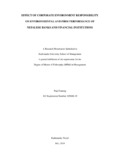
Please use this identifier to cite or link to this item:
https://hdl.handle.net/20.500.14301/454Full metadata record
| DC Field | Value | Language |
|---|---|---|
| dc.contributor.author | Tamang, Puja | - |
| dc.date.accessioned | 2024-11-22T07:14:30Z | - |
| dc.date.available | 2024-11-22T07:14:30Z | - |
| dc.date.issued | 2024-07 | - |
| dc.identifier.uri | https://hdl.handle.net/20.500.14301/454 | - |
| dc.description | A Research Dissertation Submitted to Kathmandu University School of Management in partial fulfillment of the requirement for the Degree of Master of Philosophy (MPhil) in Management | en_US |
| dc.description.abstract | The growing concerns about corporate responsibility for environmental sustainability have led the banking sector to adopt sustainable practices. In the context of Nepalese Banks and Financial Institutions (BFIs), it is vital to analyze the relationships among Corporate Environment Responsibility (CER), Green Finance (GF), Green Innovation (GI), Environmental Performance (EP), and Firm Performance (FP) to achieve both environmental and financial sustainability. Therefore, this study aims to examine the effect of CER on EP and FP and also analyze the mediating effects of GF and GI. A causal research design was adopted where the data were obtained from a sample of 426 participants using a multi-stage sampling technique. Data were collected from both online and printed forms. Exploratory Factor Analysis (EFA) and Confirmatory Factor Analysis (CFA) were employed where EFA was the first step performed to determine the factor structures. CFA was the second step executed in a different dataset to validate the output provided by EFA. Then, Covariance-Based Structural Equation Modeling (CB-SEM) technique was applied to test the research hypotheses. The findings revealed that CER has positive significant effects on GF and GI. Likewise, the effect of CER on EP and FP was also found to be positive and significant. Similarly, it was identified that GI has positive significant effects on both EP and FP. However, GF exhibited a negative insignificant effect on EP, FP, and GI as well. Additionally, GF did not mediate between the relationships of CER and both EP and FP while GI indirectly mediates these relationships. These results indicated that prioritizing environmental responsibility enhances GI and ultimately improves EP and FP of BFIs. Thus, banking and financial organizations could prioritize investments in GI to boost their environmental and firm performance and this study also | en_US |
| dc.language.iso | en | en_US |
| dc.subject | corporate environment responsibility, environmental performance, firm performance, green finance, green innovation | en_US |
| dc.title | EFFECT OF CORPORATE ENVIRONMENT RESPONSIBILITY ON ENVIRONMENTAL AND FIRM PERFORMANCE OF NEPALESE BANKS AND FINANCIAL INSTITUTIONS | en_US |
| dc.type | Thesis | en_US |
| local.school.name | KUSOM | en_US |
| local.school.program | M.Phil. in Management | en_US |
| local.school.level | M.Phil. | en_US |
| Appears in Collections: | Thesis | |
Files in This Item:
| File | Description | Size | Format | |
|---|---|---|---|---|
| PUJA TAMANG - MPHIL DISSERTATION - KUSOM - 025688-19.pdf | 1.65 MB | Adobe PDF |  View/Open |
Items in DSpace are protected by copyright, with all rights reserved, unless otherwise indicated.